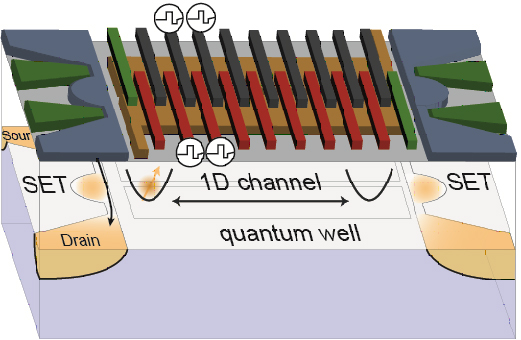Using key concepts of quantum mechanics such as superposition and entanglement, quantum computers promise to solve problems, which are intractable for all classical computers. To operate a realistic quantum computer, the quantum information has to be encoded into several of the smallest physical quantum information elements, the qubits. Thus, a realistic quantum computer requires millions of qubits and must have a scalable architecture. The spin of a single electron can encode one qubit. We have learned how to trap a single electron in silicon, how to precisely manipulate its spin, to set it in a superposition and to entangle it with another qubit. So far, these functionalities were demonstrated in devices providing not more than only two qubits.
So far, these functionalities were demonstrated in devices providing not more than only two qubits. Classical computer chips are made of silicon, based on the same technology as the electron traps and proofed to be highly scalable driving a large industry. Still, we cannot scale up a quantum chip as easily, because the qubits and thus the electrons have to be very close to each other in order to be able to interact. For a scalable architecture, we need space on the quantum chip for the required electrical connections or for embedding quantum chip elements with classical silicon electronics.
Our idea is a new functional element, the quantum bus (QuBus), which shuttles a single electron and thus the quantum information across a distance of about 10 microns. The QuBus generates the space we need for designing a scalable quantum computer architecture. It is compatible with industrial fabrication and we benefit from industrial partners such as LETI, STMicroelectronics and Intel within the consortium. At the end of the project, we aim at the demonstration of quantum teleportation across a QuBus and explore branching of a QuBus to allow for building two-dimensional fault-tolerant networks of interacting qubits on a chip.

Schematic of a QuBus. A quantum dot is formed within a Si quantum well by multi-layer metallic surface gates. Pulsing the voltages to these gates the quantum dot, which carries a single electron, is shuttled across an electrostatically formed one-dimensional channel. Single electron transistors (SET) can detect a single electron and its spin state at the ends of the QuBus.
Further reading on this topic:
Interfacing spin qubits in quantum dots and donors—hot, dense, and coherent
